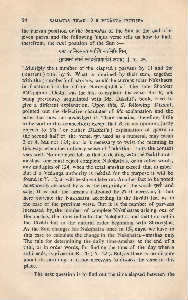Page 702 - Lokmanya Tilak Samagra (khand 2)
P. 702
54 SAMAGRA TILAK- 2 • VEDANGA JYOTI!?HA
the parvan position or -the bhdmshas of the Sun at the end of a
given parva and the following Yajus verse tells us how to find,
therefrom, the tithi position of the Sun :-
~qqf{Ur~fll~l
~ ~ ~~~l'fi~ Sfil1Fl. II Y. 25.
• Multiply the ( number of the elapsed ) parvans by 11 and the
(current) tithi by 9. What is obtained by their sum, together
with the ( number) of parvans, would be current solar Nak!Jhatra
in ( natural ) order ( from Shravi!Jh~ha ). ' The late Shankar
BiHkd!Jhl).a Dikshit was the first to explain this verse. But B, not
being previously acquainted with Mr. Dikshit's book, tried to
give a different explanation. Upon this, S, following Dikshit,
pointed out the defective character of B's explanation and the
latter has now acknowledged it. There remains, therefore, little
to be said in this connection; except that B, in my opinion, justly
objects to S's ( or rather Dikshit's ) explanation of ~.-4" in
the second half of the verse. ~if, used as a numeral, may mean
2 or 4, but not 124; nor is it necessary to twist the meaning in
this way, when the ordinary sense of • addition ' suits the context
very well. No one need tell us that in dealing with the Nak~hatra
amshas, one must reject complete Nak~hatras, or in other words,
any multiples of 124, when the total amshas exceed that number.
But if a Vedanga authority is ne~ded for the purpose it will be
found in Y. 12, as will be shown later on. Another fact to be noted
as expressly observed by S, is the propriety of the words ~ and
~. It is not the amshas ( divided by 27 if necessary ), that
here indicate the Nak~hatra according to the Javadi list, as in
the case of the previous verse. But it is the number of parvans
increased by,. the number of complete Nak~Jhatras arising out of
the amshas, that now indicates the Nak,hatra, and that too, not in
the Javadi but in the natural order beginning with Shravi~!ha.
As the Sun change his ak~hatra once in 13~ days, we have in
this case to calculate the change in the ak&hatra -amshas only
The rule for determining the daily time-amshas at the end of a
tithi, or in order words, for finding the time of the day when a
tithi ends, is given in R. 20 ( Y. 22 ). But, as there is no dispute
about its meaning, it is not necessary to discuss the verse in this
place.
The next question is to find out the time elapsed between the

